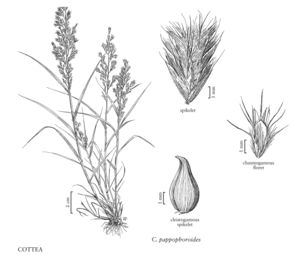Difference between revisions of "Cottea pappophoroides"
Common names: Cotta grass
Treatment appears in FNA Volume 25. Treatment on page 289.
imported>Volume Importer |
imported>Volume Importer |
||
| Line 39: | Line 39: | ||
|publication year= | |publication year= | ||
|special status= | |special status= | ||
| − | |source xml=https:// | + | |source xml=https://bitbucket.org/aafc-mbb/fna-data-curation/src/2e0870ddd59836b60bcf96646a41e87ea5a5943a/coarse_grained_fna_xml/V25/V25_939.xml |
|subfamily=Poaceae subfam. Chloridoideae | |subfamily=Poaceae subfam. Chloridoideae | ||
|tribe=Poaceae tribe Pappophoreae | |tribe=Poaceae tribe Pappophoreae | ||
Revision as of 21:06, 5 November 2020
Culms 25-70 cm. Blades 5-15 cm long, 4-7 mm wide. Panicles 8-15 cm long, 2-6 cm wide, green or purplish; branches loosely ascending. Spikelets 5-10 mm (including the awns). Glumes 4-5 mm; lemmas 3-4 mm, conspicuously long-pilose basally, awns and teeth more or less alternating. Caryopses about 1.5 mm, plump, elliptical; embryos about 1/2 as long as the caryopses. 2n = 20.
Distribution
Ariz., N.Mex., Tex.
Discussion
Cottea pappophoroides grows on open hillsides from Arizona and Texas south to central Mexico, and from Ecuador to Argentina.
Selected References
None.
Lower Taxa
None.
